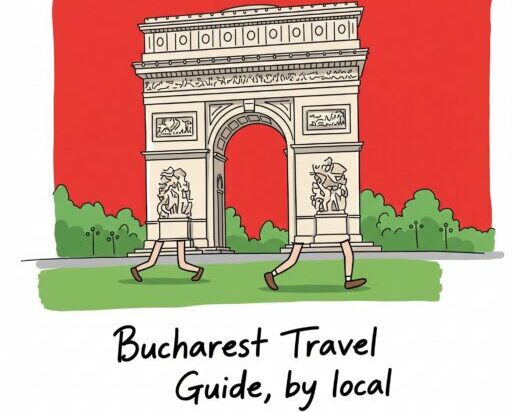BUCHAREST REVOLUTION SQUARE 1989
WHERE ROMANIAN REVOLUTION BEGAN
MEMORIALS ABOUT 1989 REVOLUTION TO SEE IN
BUCHAREST
The Revolution Square or Palace Square in Bucharest is near the NATIONAL ART MUSEUM and will become The Revolution Square after 1989.
REVOLUTION SQUARE BUCHAREST
By: BUCHAREST-TRAVEL.COM
Photographed In: Revolution Square, Bucharest
Date Uploaded:2016-03-27
Description: Revolution Square is the Place where the Romanian Revolt in 1989 burst out
BUCHAREST REVOLUTION SQUARE HISTORY
This area, the nowadays Revolution Square in the Romanian capital, was not part of Bucharest in 1730 when Kretulescu Church, one of the oldest churches in the city, was built. Around it, soon appeared houses, small shops and a tower with watch, all part of Kretulescu Inn. The boyar Iordache Kretulescu, part of Constantin Brancoveanu’s family, since he got married with the lord’s daughter owned the area, as a gift from the lord. A palace was built here between 1812 and 1815, becoming the Royal Palace until Carol I.
KING CAROL I STATUE IN REVOLUTION SQUARE BUCHAREST
By: BUCHAREST-TRAVEL.COM
Photographed In: Revolution Square, Bucharest
Date Uploaded:2016-03-27
Description: The king Carol I statue is in front of the Royal Palace in Revolution Square
REVOLUTION SQUARE, ROMANIA, BUCHAREST AND THE COMMUNISTS
In 1882 started the works for the new palace, now The Art Museum. On the other side of Victory Avenue, was built a massive construction, The Palace of Internal Affairs Ministry. This was the place where Nicolae Ceausescu ran from in December 1989. Otherwise he and his wife might have been killed by the crowd during the revolution. See where Ceausescu private house was and how he lived. More than 20.000.000 lei were paid for the land and for the construction by the Minister of Internal Affairs. Works started in 1938, stopped during the war and were finished in 1948. The building became the headquarters of the main communist organization, The Central Committee of the Romanian Communist Party until 1989 in nowadays Revolution Square in Bucharest.
COMMUNIST MINISTER OF INTERIOR HEADQUARTERS
By: BUCHAREST-TRAVEL.COM
Photographed In: Revolution Square, Bucharest
Date Uploaded:2016-03-27
Description: Part of the communist repression, here is the building Ceausescu had to run in December 1989
ANTI-COMMUNIST LEADERS MEMORIALS IN BUCHAREST REVOLUTION SQUARE
The Revolution Square was called Gheorghe Gheorghiu Dej Square in 1965, to remember the great communist leader, then it became The Republic Square. Many monuments found their place here. In 1939, Carol I equestrian statue rose until 1948 when the leaders from the Communist Party melt it. The statue can be seen again for it was remade in 2010. There is also a museum in the area, THEODOR AMAN MUSEUM. Another two statues were made here to remember the historical political parties – Corneliu Coposu and Iuliu Maniu, face to face.
MONUMENTS TO SEE IN BUCHAREST IN REVOLUTION SQUARE
By: BUCHAREST-TRAVEL.COM
Photographed In: Revolution Square, Bucharest
Date Uploaded:2016-03-27
Description: In Revolution Square there are memorials for the political leaders killed by communists
MORE TO SEE IN REVOLUTION SQUARE, BUCHAREST, ROMANIA
In 2005, to commemorate the blood bath in December 22, 1989, a monument called ,, Eternal glory to the heroes of the Romanian Revolution of December 1989’’ was placed near a small square called the Mourning Square, where a 25 meters high obelisk also rises, as a symbol of people desire for freedom. On the Memory Wall can be read the names of all 1058 victims of the communist repression in December 1989, written in brass. The stories of those who died can be read at REVOLUTION HEROES CEMETERY IN BUCHAREST!
MEMORIAL FOR VICTIMS OF 1989 REVOLUTION IN BUCHAREST, ROMANIA
By: BUCHAREST-TRAVEL.COM
Photographed In: Revolution Square, Bucharest
Date Uploaded:2016-03-27
Description: Revolution Square and the memorials for the victims of the revolution in 1989
VISIT THE REVOLUTION SQUARE AREA IN BUCHAREST, ROMANIA
On the north side of Revolution Square in Bucharest, Romania is George Enescu Square hosting the Romanian Athenaeum and in the very middle you can see KRETULESCU CHURCH. Very close to it, you can find UNIVERSITY SQUARE, another witness of the revolution in 1989 but not only, a witness of the most part of the HISTORY OF BUCHAREST. But the Revolution Square will surely be remembered in history for it was from here, from the Headquarters of the Central Committee of the Romanian Communist Party, tried to escape people’s fury. Nicolae Ceausescu took a helicopter on December 22nd, 1989, during a manifestation which was supposed to glorify him but which ended in a bloody Revolution. The helicopter took him and his wife out of Bucharest. They have been caught and executed at Targoviste City on the first Christmas day, December, 25.
REVOLUTION SQUARE MONUMENT BUCHAREST
By: BUCHAREST-TRAVEL.COM
Photographed In: Revolution Square, Bucharest
Date Uploaded:2016-03-27
Description: Monument for the victims of the Anti-Communist Revolution in 1989
SEE MAP…




Permalink //
Una plaza de Bucarest con mucha historia, es bueno tomarse, ademas de selfies, un momento para conocer la historia del lugar al que visitamos,
Permalink //
Hola Marta! Este mercado es, de hecho, el más importante para la historia de Rumania después de 1989. Gracias por visitar Bucarest Travel.
Permalink //
The monument to the victims of the Anti-Communist Revolution looks like a brain impaled on a spear. What, precisely, did the monument’s designer have in mind. I understand that local people refer to it as an olive on a stick. I saw it this week and wondered what the symbolism is. Did the designer intend for the splash of red paint at the top?